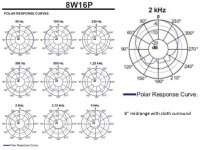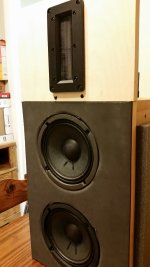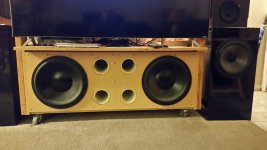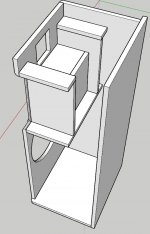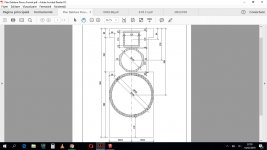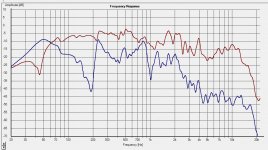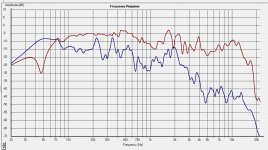AllenB i will cross the 15" at 500 hz or 400 hz
KaffiMann do you mean the subs? If so i am using two 18NW100 for 60 hz and below. The cabinets are 150l tuned to 39 hz. Maybe in the future i will change the cabinets to something larger (200-250l) tuned lower. For music they are ok. I need them to be portable for now.
The two mids do not work as well as one.
KaffiMann do you mean the subs? If so i am using two 18NW100 for 60 hz and below. The cabinets are 150l tuned to 39 hz. Maybe in the future i will change the cabinets to something larger (200-250l) tuned lower. For music they are ok. I need them to be portable for now.
Is there some reason you can not use TWO faital 6FE200 per speaker?
It's a bit difficult to find 10" and 12" with high sensitivity also, the 6.5" can be placed close together and wired in parallel for higher sensitivity. There is also a 16ohm variant of it, in case you need/want impedance matching drivers.
The two mids do not work as well as one.
I could not find polar measurements for the B&C 8PE21.LineSource I have a DBX measurement mic but i cannot measure the driver only after i buy them, and buid the enclosure.
Attached polar response of 8" pro-midrange with cloth surround suggesting match to 90-degree ME20 between 1600-1800Hz range. You will want to make 8PE21 measurements to set the best crossover frequency before you purchase expensive passive L-R-C parts.
Attachments
Thank you for all of your replies
globalplayer the Faital 6FE200 looks good but the spl is only 95 db. I need a midrange to be as loud ( or louder ) as the midbas, that has 99 db.
No, you don't. These 99dB are only reached in the mids, The spl below the baffle step is ~3-5 dB lower in the enclosure. And you'll lose also some in the LP-filter of the bass. The 6FE200 is probably not suited anyway though - it's level drops at 1,5k to ~93dB. A little dip isn't that bad but I'd prefer to have a bit headroom there since the passive XO will likely eat there a bit too.
I see another problem though, the ME20 is a bit narrow (60°), in the mid it's a lot wider without a WG. Most fullrange uses need a wider dispersion and since you can't cluster this speaker anyway, I'd suggest a bit wider dispersion horn like the excellent (and cheap!) 18s XT120 or similar.
Koifarm i don't have enough amplifiers to use active crossover, also i would like the speakers to be used on any amplifier.
The class D one and the DCX sometimes i rent it to events so i have to use the speakers with a Harman Kardon AVR132 that has 40w per channel ( enough to get to 114 db at full power on these speakers)
You could easily use some cheap & good class D mini-amp there. That will be a LOT less you're spending than on the crossover parts. And you won't have any spl issues with i.e. the 6FE200 (or different) mid driver.
Heh, thanks.  I'm not that regularily on in the forums, more like episodes, that depends on how I feel.
I'm not that regularily on in the forums, more like episodes, that depends on how I feel. 
Back to topic.. 2 of the mid drivers. Well, that can be an option but that makes the speaker very tall and well noticable the sound wandering up and down with the frequency. That can be acceptable with acutal PA use but as far as I understood it, the speaker is for home use too. The problem is, with this setup it only becomes homogenous sound in a greater distance, the shortest acceptable listening distance starts around 3-5m and that might pose a problem. I'd at first determine where you want to cross over, then try to look for a loud driver.

Back to topic.. 2 of the mid drivers. Well, that can be an option but that makes the speaker very tall and well noticable the sound wandering up and down with the frequency. That can be acceptable with acutal PA use but as far as I understood it, the speaker is for home use too. The problem is, with this setup it only becomes homogenous sound in a greater distance, the shortest acceptable listening distance starts around 3-5m and that might pose a problem. I'd at first determine where you want to cross over, then try to look for a loud driver.
It's actually a 1.5 system
For now, just a home theater sub (2x 15 inch units, but in a common enclosure)
______________________________________________________________
I neglected to mention in my previous post, that I have these 2x 6fe200's
in a 1.5 configuration, for the exact reasons mentioned above. The highs are rolled off of the bottom unit, and said bottom unit is utilized to compensate for baffle step diffraction. Smaller sized mid range units, such as the 5 or 6 inch range, when used in singles, often times sound a bit to "thin" in the lower mid range, for my tastes.
Ahem... Great minds and all that...
What are you matching them with down low?
For now, just a home theater sub (2x 15 inch units, but in a common enclosure)
______________________________________________________________
I neglected to mention in my previous post, that I have these 2x 6fe200's
in a 1.5 configuration, for the exact reasons mentioned above. The highs are rolled off of the bottom unit, and said bottom unit is utilized to compensate for baffle step diffraction. Smaller sized mid range units, such as the 5 or 6 inch range, when used in singles, often times sound a bit to "thin" in the lower mid range, for my tastes.
Attachments
Last edited:
I see another problem though, the ME20 is a bit narrow (60°), in the mid it's a lot wider without a WG. Most fullrange uses need a wider dispersion and since you can't cluster this speaker anyway, I'd suggest a bit wider dispersion horn like the excellent (and cheap!) 18s XT120 or similar.
Because the waveguides are verry cheap (20E) i will buy the ME20 and if its not compatible with the midrange i will try the XT120.
I made some changes to the enclosure, the internal volume now is 100 liters and i changed the ports. The new ports are 5x30 cm and there are two of them.
I am not sure of what tunning i should chose for 15NDL88.
The midrange has it's own enclosure at about 6.8 liters closed.
Attachments
Because the waveguides are verry cheap (20E) i will buy the ME20 and if its not compatible with the midrange i will try the XT120.
The XT120 is also only 20€.
Edit: I would advise not to put the ports besides the mid if not absolutely necessary. The baffle becomes narrower for the mid and the baffle step jumps up to a much higher frequency - you lose spl in the important low mids and you'll lose linearity aswell. I would use tubes which have 3 advantages: You can shorten or replace them (which you can't with the slot ones) for bigger length if you realize you'd like a different BR tuning and they eat up less volume in the speaker. If you know the tuning is what you want, slots are fine but it would be better to move them.
Last edited:
Another opinion on baffle design.
1) I would not put the ports near the midrange to avoid mixing mid + deep bass air pressure waves, and creating extra nasty diffraction effects as the midrange pressure wave falls into the side ports. I would put two round ports a few inches below the woofer spaced about 20% away from each side panel. You can still experiment to cover over the side ports and cut the lower round ports.
2) I would mount the woofer about 3-4 inches below the midrange in order to provide both "woofer breathing" room plus enough separation for a "shelf brace" which is also part of the sealed volume midrange cabinet. Since cabinet volume for the midrange is small, the current baffle is acceptable with some attention to the midrange cabinet construction, plus a self brace supporting the woofer magnet -- which spreads the woofer vibration energy around all cabinet panels -- thus reducing woofer front baffle vibrations transfer to the midrange. I am not a fan of putting a large rubber gasket around the midrange frame-to-baffle mount for vibration reduction.
1) I would not put the ports near the midrange to avoid mixing mid + deep bass air pressure waves, and creating extra nasty diffraction effects as the midrange pressure wave falls into the side ports. I would put two round ports a few inches below the woofer spaced about 20% away from each side panel. You can still experiment to cover over the side ports and cut the lower round ports.
2) I would mount the woofer about 3-4 inches below the midrange in order to provide both "woofer breathing" room plus enough separation for a "shelf brace" which is also part of the sealed volume midrange cabinet. Since cabinet volume for the midrange is small, the current baffle is acceptable with some attention to the midrange cabinet construction, plus a self brace supporting the woofer magnet -- which spreads the woofer vibration energy around all cabinet panels -- thus reducing woofer front baffle vibrations transfer to the midrange. I am not a fan of putting a large rubber gasket around the midrange frame-to-baffle mount for vibration reduction.
So regarding port position, a friend of mine who has helped me in designing these speakers (ionutgaga) made some tests a while ago.
He used two speakers that were almost identical but one had it's ports under the midbas, at the lowest end of the enclosure, and the other had it's ports between the midbas and the driver, in the middle of the enclosure. Ports sizes were almost identical.
Then he measured both the drivers and ports and got these results:
The one on the left is the one with the ports under the midbas.
He used two speakers that were almost identical but one had it's ports under the midbas, at the lowest end of the enclosure, and the other had it's ports between the midbas and the driver, in the middle of the enclosure. Ports sizes were almost identical.
Then he measured both the drivers and ports and got these results:
The one on the left is the one with the ports under the midbas.
Attachments
I know similar measurements and I could almost swear the measurements are just the opposite. Are you absolutely sure they aren't switched? The cancelling unter angle at 200 are extremly typical for dual or very large ports beside the midrange driver because of interferences.
Both are very bad. Emission from the port should show only one peak and only at 50 Hz, not everywhere!Then he measured both the drivers and ports and got these results:
- Home
- Loudspeakers
- Multi-Way
- 15 Inch 3 way
